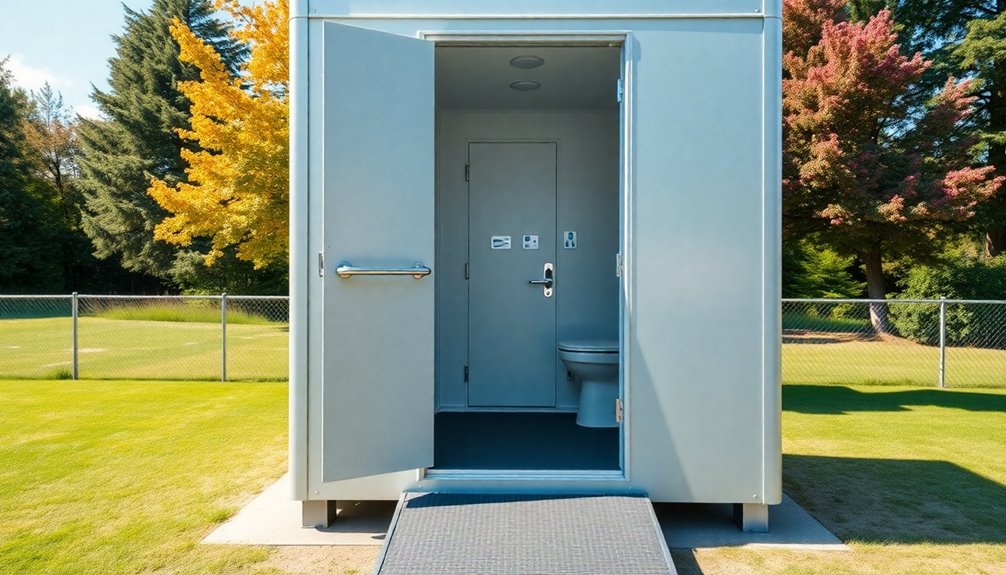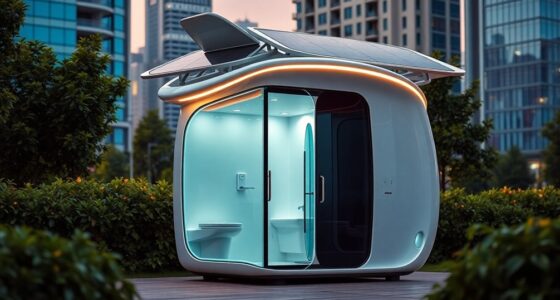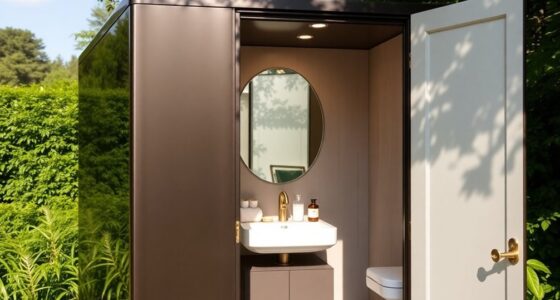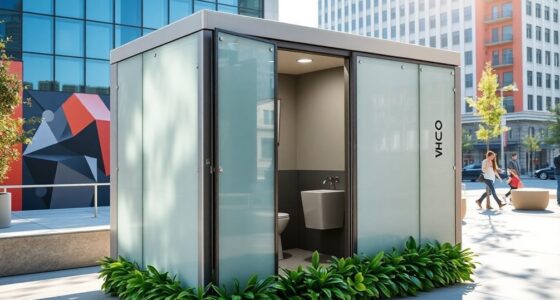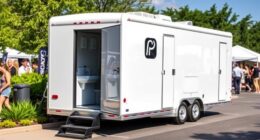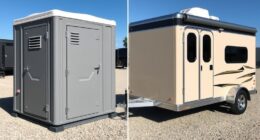Design innovations for accessibility in portable restrooms focus on making these facilities inclusive for everyone. You'll find spacious interiors that allow for easy maneuverability, with grab bars for support. Ground-level entries guarantee seamless access, while compliance with ADA standards assures safety and usability. Features like non-slip surfaces, accessible sinks, and eco-friendly solutions enhance your experience. Keep exploring to discover more about the latest advancements in portable restroom design and how they cater to diverse needs at public events.
Key Takeaways
- Spacious interiors with a minimum diameter of 60 inches allow easy maneuverability for wheelchair users and individuals with mobility aids.
- Grab bars positioned at 33 to 36 inches provide essential support during transfers, enhancing safety and independence.
- Wider doorways of at least 32 inches ensure seamless access for all users, including those using wheelchairs.
- Non-slip flooring and high-contrast colors improve safety and visibility, reducing fall risks in wet conditions.
- Eco-friendly features, such as waterless urinals and solar-powered lighting, promote sustainability while enhancing overall restroom accessibility.
Understanding the Importance of Accessibility in Portable Restrooms
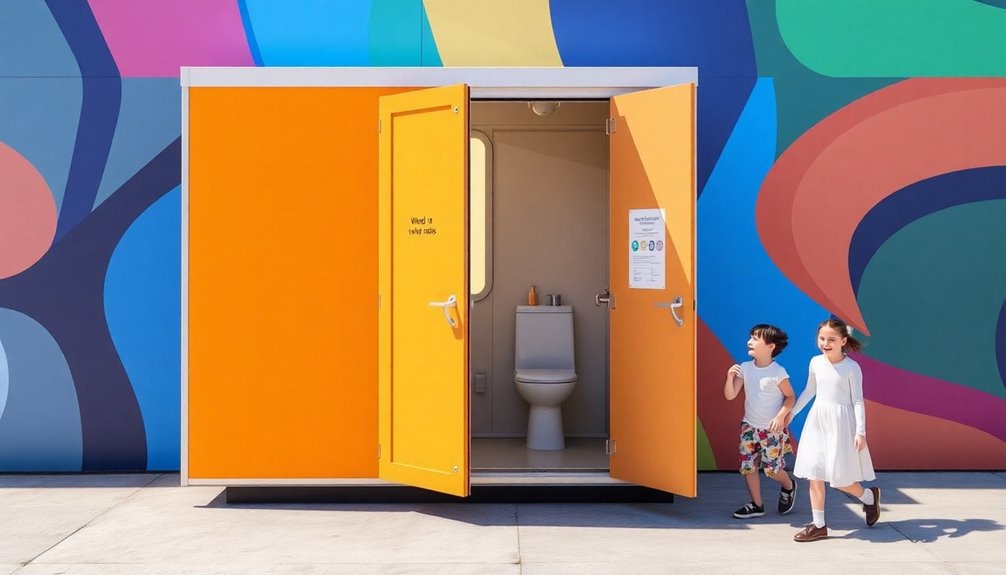
When it comes to public events and construction sites, ensuring accessibility in portable restrooms isn't just a legal requirement; it's a commitment to inclusivity. Accessible portable restrooms cater to individuals with disabilities, allowing them to use facilities independently and comfortably.
To promote safety, these restrooms should feature spacious interiors, grab bars, and ground-level entries, enabling wheelchair users to maneuver easily. Non-slip flooring is essential to prevent slips, especially in wet conditions.
Compliance with the ADA is vital, ensuring that event organizers meet legal standards while fostering a welcoming atmosphere. Adequate planning, including proper placement and clear signage, enhances the user experience, making it easier for everyone to locate and utilize these facilities with ease and confidence.
Key Design Features for Inclusive Portable Restrooms
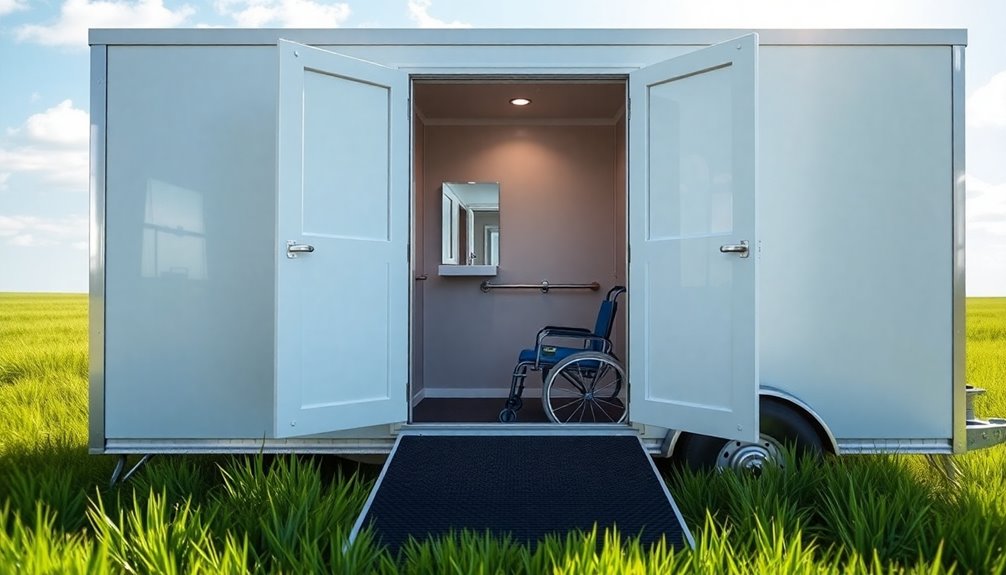
When designing inclusive portable restrooms, consider spacious interiors that allow everyone to move freely.
Accessible fixture placement guarantees that all users can reach what they need without difficulty.
Plus, clear signage options help guide individuals, making the restroom easy to find and use.
Spacious Interior Design
To guarantee everyone can use portable restrooms comfortably, spacious interior design is fundamental.
Accessible portable restrooms feature spacious interiors that allow wheelchair users ample room to maneuver and maintain independence. With a minimum recommended width and depth of over 60 inches, these restrooms provide sufficient turning space for mobility aids.
Strategically placed grab bars offer essential support for users transferring from wheelchairs to the toilet, enhancing safety and confidence. Ground-level entry or ramps eliminate barriers, making access easier for individuals with mobility challenges.
Additionally, non-slip flooring is important in these larger spaces, preventing accidents and ensuring a secure environment.
Accessible Fixture Placement
Spacious interiors set the stage for accessible fixture placement, guaranteeing that every feature caters to the needs of users with mobility challenges.
To create an inclusive environment, consider these essential design elements:
- Grab bars positioned at appropriate heights to assist during transfers from wheelchairs.
- Sinks and hand sanitizers accessible to wheelchair users, ideally set at a height of 34 inches.
- Non-slip flooring to prevent slips and falls, especially in wet conditions.
Providing adequate space with a minimum turning radius of 60 inches allows wheelchair users to navigate comfortably.
It's vital to incorporate clear signage to indicate accessible features, enhancing usability for those facing mobility issues.
These thoughtful designs guarantee everyone can use portable restrooms safely and comfortably. Additionally, ensuring proper air quality improvement can create a more pleasant environment for all users.
Clear Signage Options
Effective signage in portable restrooms greatly enhances accessibility for all users, especially those with visual impairments.
You can create an accessible environment by incorporating clear signage that includes braille and tactile indicators. Use high-contrast colors and large fonts to guarantee legibility in various lighting conditions, making it easy for everyone to quickly identify restroom options.
Visual symbols, like universally recognized icons for gender-neutral and accessible facilities, communicate effectively to diverse user groups. Regular maintenance and updates of signage are essential for accuracy and visibility, promoting a positive user experience.
Furthermore, strategic placement of directional signage throughout the venue guides attendees to the nearest accessible portable restrooms, further improving accessibility for all.
Enhancing User Experience With Spacious Interiors
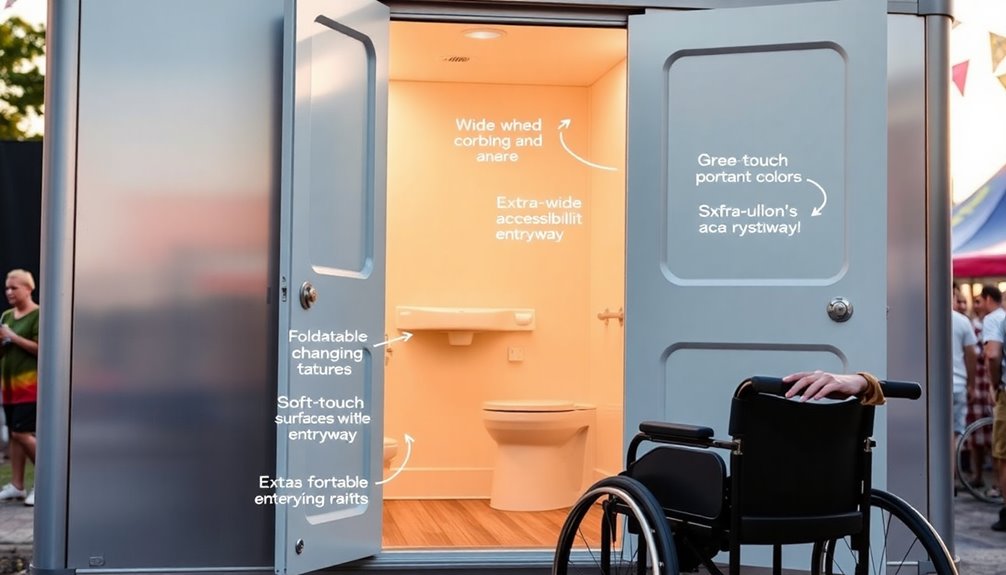
When it comes to portable restrooms, creating a welcoming environment can markedly improve the user experience for everyone, especially those with mobility challenges.
Spacious interiors are essential for wheelchair users, allowing easy maneuverability and independence. Here are some key features that enhance accessibility:
- A minimum interior space of 60 inches in diameter for comfortable turning.
- Wider doorways of at least 32 inches for seamless entry and exit.
- High-contrast colors and non-slip flooring to enhance safety and visibility.
These elements of inclusive design not only guarantee that all users can access facilities but also contribute to a more positive experience.
The Role of Grab Bars and Support Systems

Grab bars are essential for providing stability in portable restrooms, especially for those with mobility challenges.
When designed thoughtfully, these support systems can greatly enhance user safety and comfort.
You'll find that proper placement and maintenance of grab bars make a world of difference in creating an accessible environment.
Importance of Stability Features
While many may overlook the importance of stability features in portable restrooms, the presence of grab bars and support systems is essential for guaranteeing safety and independence for users with mobility challenges.
These features not only enhance accessibility but also provide a dignified experience for individuals with disabilities.
Consider these key aspects:
- Safety: Grab bars considerably reduce the risk of falls, especially in wet conditions.
- Independence: Properly installed support systems allow for easier transfers to and from wheelchairs.
- Compliance: Adhering to ADA guidelines guarantees grab bars can withstand necessary force, promoting confidence in their use.
Moreover, the implementation of these features can lead to improved cooperative co-parenting plans, ensuring that everyone's needs are considered during public events.
Design Considerations for Support
To guarantee safe and comfortable use of portable restrooms, thoughtful design of support systems is essential. Grab bars are key accessibility features, providing stability for individuals with mobility challenges during safe transfers to and from the toilet. Following ADA guidelines, these bars should be mounted between 33 and 36 inches from the floor, assuring maximum usability. Made from slip-resistant materials and designed to support at least 250 pounds, they enhance the safety of inclusive bathrooms. Additionally, foldable grab bars optimize space efficiency without compromising support. It is crucial to consider that emotional dysregulation can affect individuals' ability to navigate spaces safely, highlighting the importance of inclusive design.
| Feature | Specification | Benefit |
|---|---|---|
| Grab Bars | 33-36 inches from floor | Assures safety |
| Weight Capacity | Minimum 250 pounds | Supports all users |
| Foldable Design | Space-efficient | Maximizes restroom space |
Ground-Level Entry: Making Access Easier
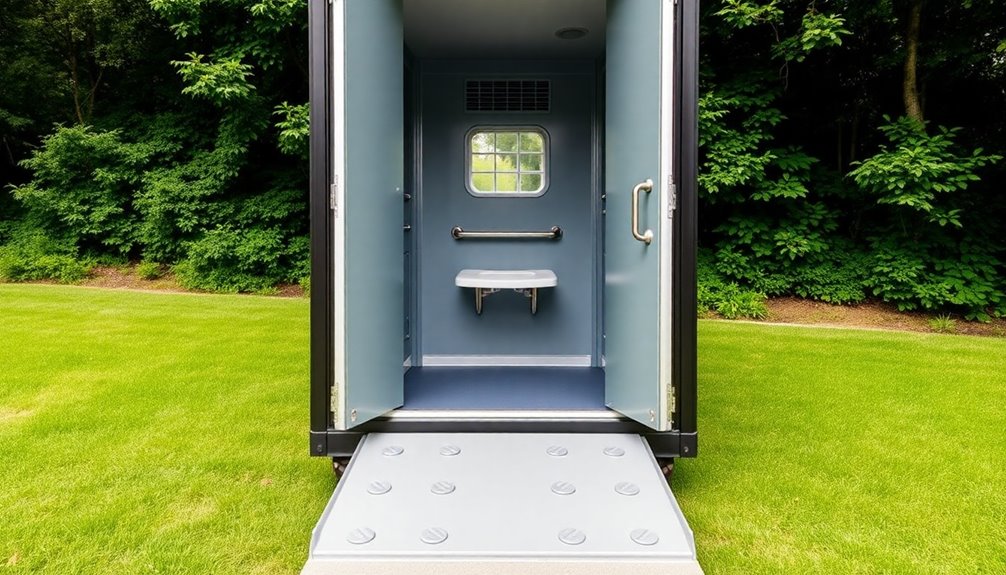
Ground-level entry in portable restrooms greatly improves accessibility for everyone, especially those using mobility aids like wheelchairs or walkers. By eliminating barriers, you can access facilities independently and comfortably.
Key features of ground-level entry include:
- Ramps with a 1:12 slope: These meet ADA standards and guarantee easy access for wheelchair users.
- Wide doorways (at least 32 inches): This design promotes maneuverability and allows assistance when needed.
- Non-slip surfaces: These enhance safety, reducing fall risks in wet or outdoor environments.
Incorporating these elements fosters inclusivity and enhances user dignity, guaranteeing that all individuals can utilize restroom facilities without stigma.
Ground-level entries create an environment where everyone feels comfortable and respected.
Non-Slip Flooring: Ensuring Safety for All Users
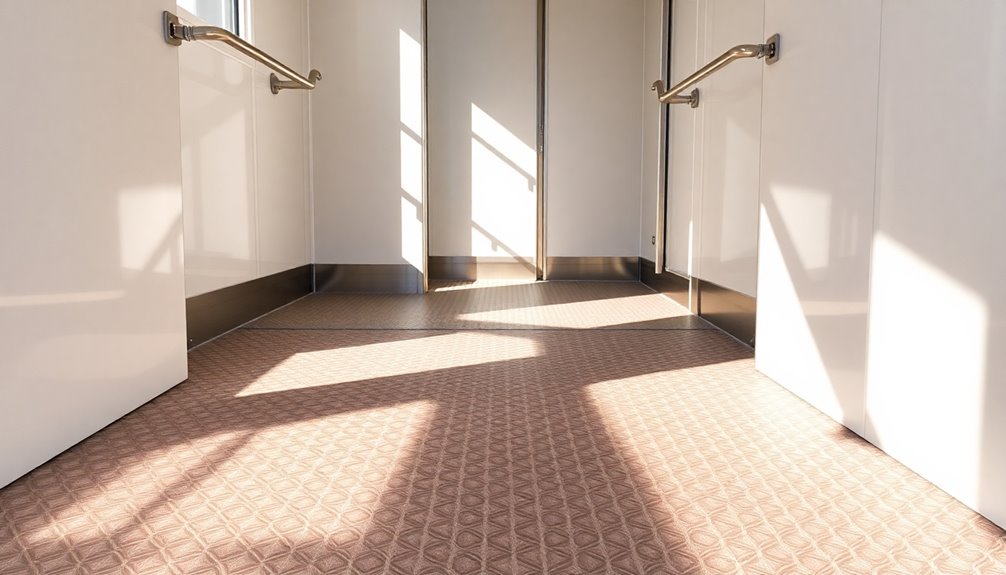
Ensuring safety in portable restrooms goes hand-in-hand with features like ground-level entry. One essential element is non-slip flooring, which greatly reduces the risk of slips and falls, especially in wet conditions.
This flooring is accessible for all users, including those with mobility challenges. Materials like textured vinyl or rubber provide excellent traction while being easy to clean, enhancing user confidence.
Compliance with the Americans with Disabilities Act (ADA) often mandates non-slip surfaces, ensuring equitable access for everyone.
Additionally, non-slip flooring contributes to the overall aesthetics of portable restrooms, creating a clean and modern look.
Compliance With Accessibility Standards and Regulations
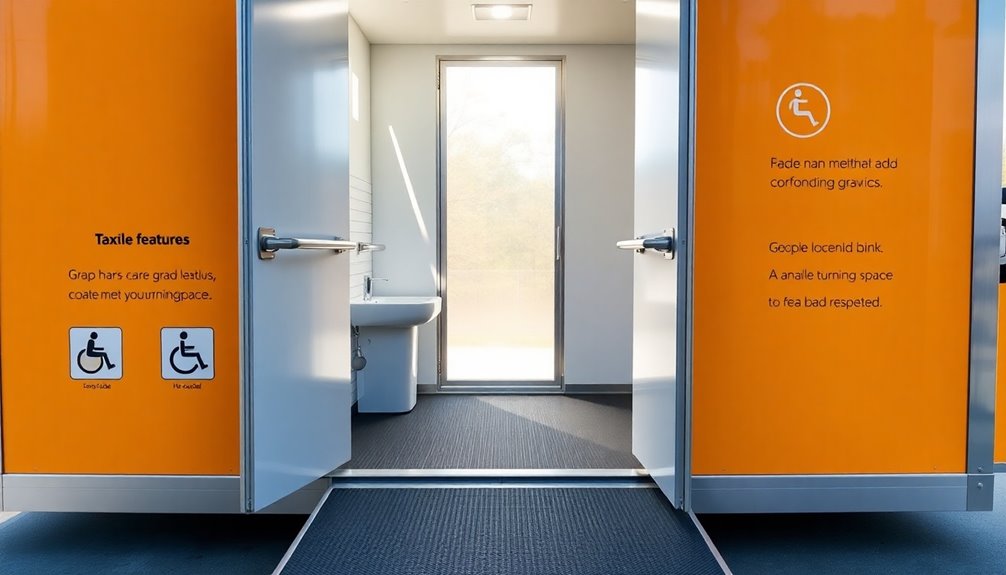
While ensuring accessibility in portable restrooms is essential for everyone, compliance with standards and regulations like the Americans with Disabilities Act (ADA) is non-negotiable.
You need to make sure that your accessible portable toilets meet specific requirements to provide equitable access.
- At least 5% must be accessible at public events.
- They should have a minimum interior space of 60 inches for wheelchair maneuverability, along with grab bars positioned between 33 and 36 inches from the floor.
- Ground-level entry or ramps with a maximum slope of 1:12 are necessary, along with non-slip flooring to enhance safety.
Regular maintenance is vital for compliance with health and safety regulations, ensuring a positive user experience for everyone.
The Impact of Portable Restrooms on Public Events
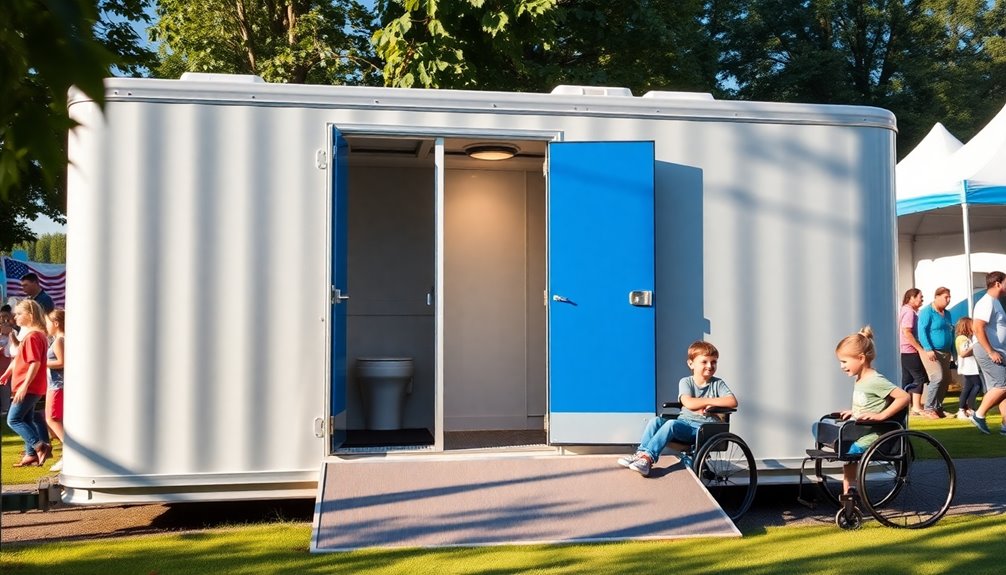
Portable restrooms play an essential role in enhancing accessibility at public events, ensuring everyone can enjoy the experience.
By addressing diverse user needs, these facilities not only comply with regulations but also foster an inclusive environment.
Plus, eco-friendly waste solutions associated with portable restrooms contribute to a sustainable event experience that benefits all attendees. These solutions not only reduce the environmental impact of events but also ensure that facilities are maintained in a hygienic and accessible manner. By implementing effective postevent cleanup strategies for restrooms, organizers can further enhance sustainability efforts, minimizing waste and promoting cleanliness. This commitment to eco-friendliness not only impresses attendees but also fosters a culture of responsibility towards the planet.
Enhancing Event Accessibility
Accessibility is essential for creating inclusive public events, and providing adequate portable restrooms is a key component of that effort.
Event planners must prioritize accessible portable restrooms to meet the standards set by the Americans with Disabilities Act (ADA).
Consider these critical features:
- Grab bars and spacious interiors for those with mobility aids
- Strategic placement throughout the venue for easy access
- Regular maintenance and cleanliness to guarantee a positive user experience
Eco-Friendly Waste Solutions
As event organizers seek to minimize their environmental impact, eco-friendly waste solutions have become essential in the planning process. Portable restrooms equipped with waterless urinals save thousands of gallons of water annually, making them a sustainable choice. Many modern units utilize solar-powered lighting, reducing carbon footprints considerably. Biodegradable waste management systems convert waste into compost, enhancing overall sustainability. Incorporating hand sanitizers instead of traditional washing stations not only conserves water but also boosts hygiene. By opting for these eco-friendly restroom solutions, you show a commitment to environmental responsibility, appealing to eco-conscious attendees. Additionally, just as vibrational alignment can enhance experiences in various areas of life, it can also foster a positive atmosphere at events by ensuring attendee comfort and satisfaction.
| Feature | Benefits | Impact |
|---|---|---|
| Waterless Urinals | Save water | Sustainable resource use |
| Solar-Powered Lighting | Reduce energy consumption | Lower carbon footprint |
| Biodegradable Systems | Convert waste to compost | Enhance sustainability |
Diverse User Needs
When planning public events, it's essential to take into account the diverse needs of all attendees, particularly those with disabilities. Ensuring accessibility isn't just about compliance with the Americans with Disabilities Act (ADA); it's about creating a more inclusive atmosphere.
Accessible portable restrooms play an important role in this.
- They cater to various physical abilities, ensuring everyone can participate.
- Clear signage and strategic placement help attendees locate facilities easily.
- Prioritizing accessible options enhances overall satisfaction and encourages attendance.
Best Practices for Maintenance and Cleanliness
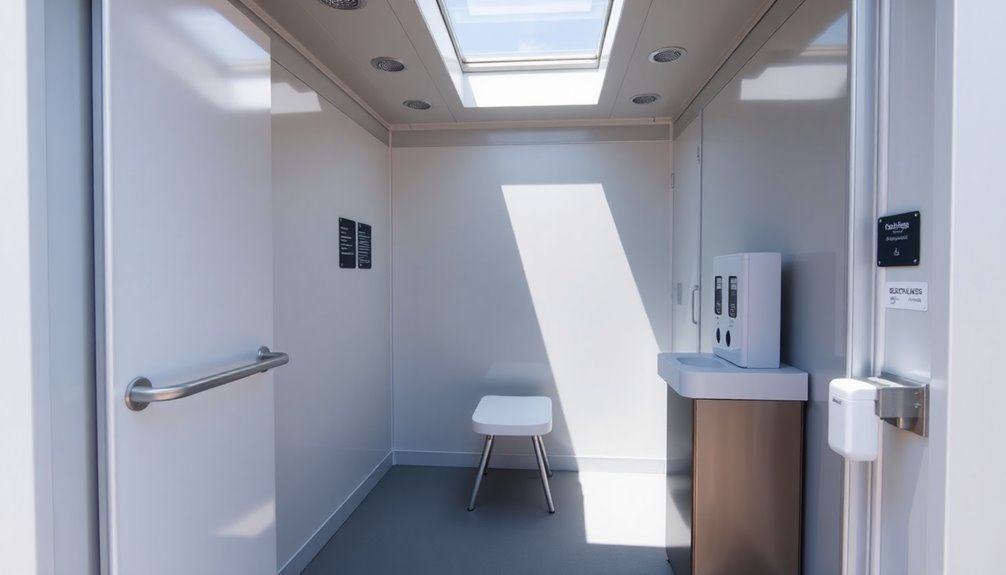
To guarantee portable restrooms remain clean and inviting, establishing a regular maintenance schedule is essential. Aim for daily cleanings at events to maintain hygiene and enhance user satisfaction.
Use high-quality, eco-friendly cleaning products to effectively sanitize surfaces while minimizing environmental impact. Equip each portable restroom with hand sanitizers, replenishing them frequently to promote hygiene and reduce germ spread.
Clear signage indicating maintenance schedules and contact information boosts confidence in the cleanliness and accessibility of facilities.
After events, conducting user feedback surveys helps identify specific cleanliness concerns and areas for improvement. Additionally, implementing advanced cleaning technology can further ensure that restrooms are maintained to a high standard, enhancing user experience.
Future Trends in Accessible Portable Restroom Design
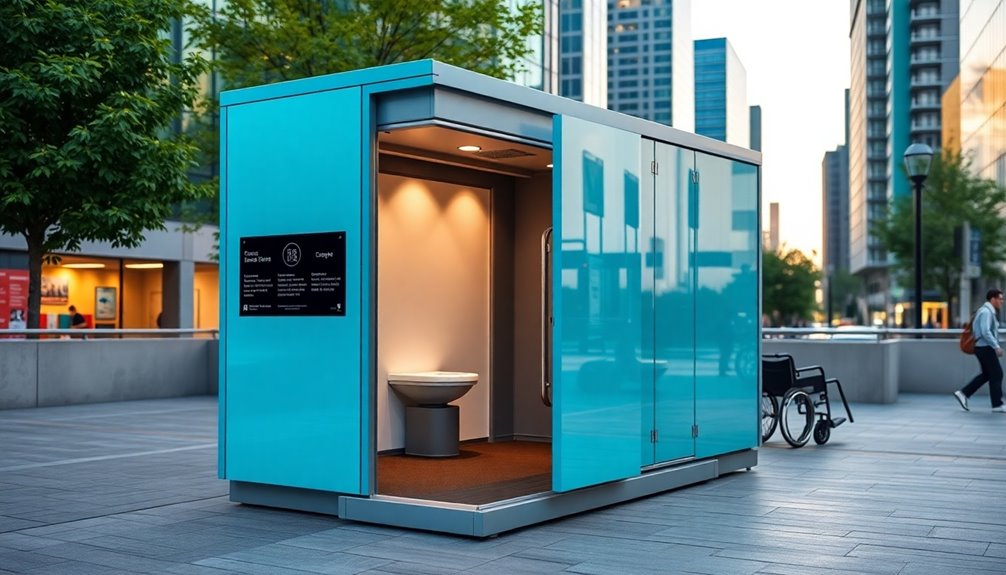
What innovative features can we expect in the future of accessible portable restroom design? The landscape is evolving with exciting design innovations that enhance accessibility and user experience.
Here are some trends that'll shape the future:
- Smart technology: IoT sensors will monitor usage and maintenance, ensuring restrooms are always ready for everyone.
- Modular designs: Customizable layouts will adapt to various event sizes and accessibility needs, promoting inclusivity.
- Eco-friendly materials: Sustainable features like solar-powered lighting and waterless urinals will reduce environmental impact.
Collaboration between designers, manufacturers, and advocacy groups is essential to incorporate feedback, ensuring enhanced accessibility features—like automated doors and touchless fixtures—meet the diverse needs of all users effectively.
Frequently Asked Questions
How Can I Make My Public Bathroom More Accessible?
To make your public bathroom more accessible, start by ensuring there's enough space for wheelchair users to navigate comfortably.
Install grab bars near toilets for added support and consider a ground-level entry or ramp for easy access.
Use non-slip flooring to enhance safety, and add clear, high-contrast signage with braille for those with visual impairments.
These improvements will create an inclusive environment, allowing everyone to use the facilities with ease and dignity.
How to Design an Accessible Bathroom?
Designing an accessible bathroom isn't just about adding a few grab bars; it's like creating a sanctuary of inclusivity!
You'll want to guarantee the space is generously wide—at least 60 inches—to allow for smooth wheelchair navigation.
Don't forget those grab bars, positioned perfectly between 33 to 36 inches for support.
Incorporate non-slip flooring to prevent slips and guarantee clear signage guides everyone effortlessly.
Make it a space where everyone feels welcome and safe!
Are Porta Potties ADA Compliant?
Yes, porta potties can be ADA compliant if they meet specific criteria.
You'll want to verify they've adequate interior space for wheelchair maneuverability, grab bars for support, and a ground-level entry or ramp for easy access.
Non-slip floors are essential for safety, especially in wet conditions.
Finally, clear signage indicating their location can greatly help those seeking accessible facilities at events or construction sites.
How Do Luxury Portable Restrooms Work?
Imagine stepping into a lavish oasis amidst the chaos of an event.
Luxury portable restrooms work by combining comfort and functionality. You'll find spacious interiors with climate control, flushable toilets, and running water sinks.
Eco-friendly technologies, like solar-powered lighting, enhance your experience while being kind to the planet.
With thoughtful features like hands-free soap dispensers and elegant finishes, you'll feel like you've walked into a five-star restroom, no matter where you are.
Conclusion
By prioritizing accessibility in portable restrooms, you're not just meeting regulations; you're fostering an inclusive environment for everyone. When you incorporate thoughtful design features—like spacious interiors and grab bars—you enhance the user experience, making events more enjoyable for all. The truth is, accessible design isn't just a requirement; it's an opportunity to show that every individual deserves dignity and comfort. Embrace these innovations, and you'll create spaces where everyone feels welcome and valued.
